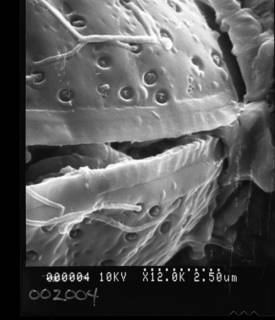WoRMS taxon details
Prorocentrum mexicanum Osorio-Tafall, 1942
231885 (urn:lsid:marinespecies.org:taxname:231885)
accepted
Species
Prorocentrum rathymum Loeblich, Shirley & Schmidt · unaccepted (synonym)
marine, fresh, terrestrial
Not documented
LSID urn:lsid:algaebase.org:taxname:42609
Description Clearly distinct from P. rhathymum, according to Cortés-Altamirano and Sierra-Beltrán (2003). Cells 30–40 μm in length...
Taxonomy The species was suggested by Gomez et al. (2017) to be a synonym of Prorocentrum mexicanum. However, the two species...
LSID urn:lsid:algaebase.org:taxname:42609 [details]
Description Clearly distinct from P. rhathymum, according to Cortés-Altamirano and Sierra-Beltrán (2003). Cells 30–40 μm in length...
Description Clearly distinct from P. rhathymum, according to Cortés-Altamirano and Sierra-Beltrán (2003). Cells 30–40 μm in length and 20–30 μm in width. Valval pores radiating and a line of pores along the margins. From Lassus et al. 2016.
[details]
[details]
Taxonomy The species
Taxonomy The species was suggested by Gomez et al. (2017) to be a synonym of Prorocentrum mexicanum. However, the two species differ in both morphology and ecology. P. rhathymum is a benthic marine dinoflagellate with a characteristic pattern of trichocyst pores on the thecal plates, some of which are arranged in radiating lines towards the lateral sides. P. mexicanum is from the marine phytoplankton and it is unclear from the original description whether it has radiating lines of trichocyst pores (likely not), the pores are scattered on thecal surface. See Hoppenrath et al. (2014) for further information on P. rhathymum. Further studies of the species complex (P. mexicanum, P. rhathymum, P. steidingeae) are needed to clarify species delimitations and synonymy. [details]
Guiry, M.D. & Guiry, G.M. (2024). AlgaeBase. World-wide electronic publication, National University of Ireland, Galway (taxonomic information republished from AlgaeBase with permission of M.D. Guiry). Prorocentrum mexicanum Osorio-Tafall, 1942. Accessed through: World Register of Marine Species at: https://www.marinespecies.org/aphia.php?p=taxdetails&id=231885 on 2024-04-24
Date
action
by
Copyright notice: the information originating from AlgaeBase may not be downloaded or replicated by any means, without the written permission of the copyright owner (generally AlgaeBase). Fair usage of data in scientific publications is permitted.
additional source
Guiry, M.D. & Guiry, G.M. (2023). AlgaeBase. <em>World-wide electronic publication, National University of Ireland, Galway.</em> searched on YYYY-MM-DD., available online at http://www.algaebase.org [details]
additional source Tomas, C.R. (Ed.). (1997). Identifying marine phytoplankton. Academic Press: San Diego, CA [etc.] (USA). ISBN 0-12-693018-X. XV, 858 pp., available online at http://www.sciencedirect.com/science/book/9780126930184 [details]
additional source Zenetos, A.; Çinar, M.E.; Pancucci-Papadopoulou, M.A.; Harmelin, J.-G.; Furnari, G.; Andaloro, F.; Bellou, N.; Streftaris, N.; Zibrowius, H. (2005). Annotated list of marine alien species in the Mediterranean with records of the worst invasive species. <em>Mediterranean Marine Science.</em> 6 (2): 63-118., available online at https://www.researchgate.net/publication/273213810_Annotated_list_of_marine_alien_species_in_the_Mediterranean_with_records_of_the_worst_invasive_species [details] Available for editors [request]
[request]
additional source Steidinger, K. A., M. A. Faust, and D. U. Hernández-Becerril. 2009. Dinoflagellates (Dinoflagellata) of the Gulf of Mexico, Pp. 131–154 in Felder, D.L. and D.K. Camp (eds.), Gulf of Mexico–Origins, Waters, and Biota. Biodiversity. Texas A&M Press, College [details]
additional source Zenetos, A.; Meriç, E.; Verlaque, M.; Galli, P.; Boudouresque, C.-F.; Giangrande, A.; Cinar, M.; Bilecenoglu, M. (2008). Additions to the annotated list of marine alien biota in the Mediterranean with special emphasis on Foraminifera and Parasites. <em>Mediterranean Marine Science.</em> 9(1): 119-165., available online at https://doi.org/10.12681/mms.146 [details] Available for editors [request]
[request]
additional source Tomas, C.R. (Ed.). (1997). Identifying marine phytoplankton. Academic Press: San Diego, CA [etc.] (USA). ISBN 0-12-693018-X. XV, 858 pp., available online at http://www.sciencedirect.com/science/book/9780126930184 [details]
additional source Zenetos, A.; Çinar, M.E.; Pancucci-Papadopoulou, M.A.; Harmelin, J.-G.; Furnari, G.; Andaloro, F.; Bellou, N.; Streftaris, N.; Zibrowius, H. (2005). Annotated list of marine alien species in the Mediterranean with records of the worst invasive species. <em>Mediterranean Marine Science.</em> 6 (2): 63-118., available online at https://www.researchgate.net/publication/273213810_Annotated_list_of_marine_alien_species_in_the_Mediterranean_with_records_of_the_worst_invasive_species [details] Available for editors
additional source Steidinger, K. A., M. A. Faust, and D. U. Hernández-Becerril. 2009. Dinoflagellates (Dinoflagellata) of the Gulf of Mexico, Pp. 131–154 in Felder, D.L. and D.K. Camp (eds.), Gulf of Mexico–Origins, Waters, and Biota. Biodiversity. Texas A&M Press, College [details]
additional source Zenetos, A.; Meriç, E.; Verlaque, M.; Galli, P.; Boudouresque, C.-F.; Giangrande, A.; Cinar, M.; Bilecenoglu, M. (2008). Additions to the annotated list of marine alien biota in the Mediterranean with special emphasis on Foraminifera and Parasites. <em>Mediterranean Marine Science.</em> 9(1): 119-165., available online at https://doi.org/10.12681/mms.146 [details] Available for editors
 Present
Present  Present in aphia/obis/gbif/idigbio
Present in aphia/obis/gbif/idigbio  Inaccurate
Inaccurate  Introduced: alien
Introduced: alien  Containing type locality
Containing type locality
From editor or global species database
LSID urn:lsid:algaebase.org:taxname:42609 [details]From regional or thematic species database
Description Clearly distinct from P. rhathymum, according to Cortés-Altamirano and Sierra-Beltrán (2003). Cells 30–40 μm in length and 20–30 μm in width. Valval pores radiating and a line of pores along the margins. From Lassus et al. 2016.[details]
Harmful effect P. mexicanum is included in Lassus et al.(2016) as harmful. It is mentioned as producing haemolytic toxins of unknown nature. However, as the material on which this information is based is benthic, it is likely that the information relates to Prorocentrum rhathymum, not P. mexicanum.
Lassus et al. (2016) further mention that P. mexicanum produces FAT. However, the information referred to is from a congress abstract and the organism was not identified further. Its identity is therefore somewhat uncertain (Tindall et al. 1981).
True P. mexicanum needs to be refound and its harmful potential to be re-examined. [details]
Taxonomy The species
Published in AlgaeBase 
Published in AlgaeBase (from synonym Prorocentrum rathymum Loeblich, Shirley & Schmidt)
(from synonym Prorocentrum rathymum Loeblich, Shirley & Schmidt)
To Barcode of Life (1 barcode)
To Biodiversity Heritage Library (3 publications)
To European Nucleotide Archive (ENA)
To GenBank (74 nucleotides; 0 proteins)
To NMNH Extant Collection (002004.jpg)
To NMNH Extant Collection (002005.jpg)
To ITIS

Published in AlgaeBase
 (from synonym Prorocentrum rathymum Loeblich, Shirley & Schmidt)
(from synonym Prorocentrum rathymum Loeblich, Shirley & Schmidt)To Barcode of Life (1 barcode)
To Biodiversity Heritage Library (3 publications)
To European Nucleotide Archive (ENA)
To GenBank (74 nucleotides; 0 proteins)
To NMNH Extant Collection (002004.jpg)
To NMNH Extant Collection (002005.jpg)
To ITIS

